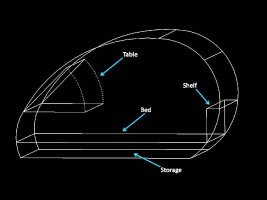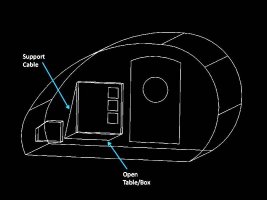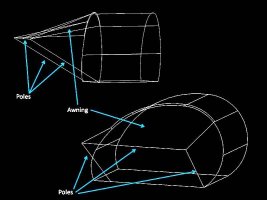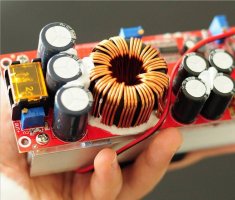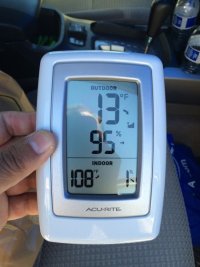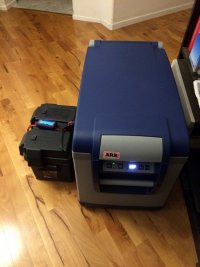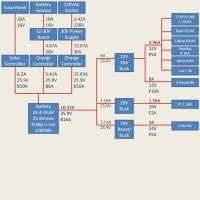It's been a while since I first started this thread, but I've been learning and designing, and I've finally gotten to the point where I can start figuring out the electrics and the battery. The link in the first post to the trailer build should still work if you want details, but here are the latest design pics of the actual trailer:
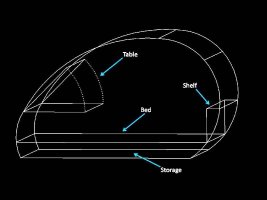
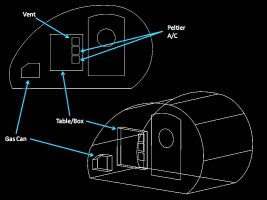
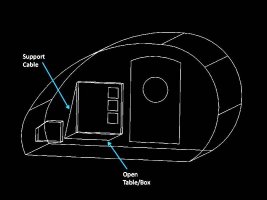

I'm toying with the idea of installing a couple of peltier coolers for hot days. Originally, I had considered a DIY evaporative cooler. But it would have been bulky, required lots of water, and I was concerned about condensation in such a small area. I think the peltiers will work much better. They're a bit power hungry, but I plan to use them at 25-75% capacity. Apparently, that will make them more energy efficient. Here's what I kind of have in mind:

I've been shopping for the various components I'd like to use for the trailer as far as electrical stuff goes, and I've taken note of the power requirements of each device. Another thing I had to consider is what battery chemistry to use. Lead/Acid was out; too heavy. LiFePO4 was out; I can't afford them. So I'm back to good ol' 18650 Li-Ions. So 3s or 4s? The question that forever vexes people who want to make a 12V battery out of Li-Ion. I've decided to go with 4s. For me, it makes sense to have the higher voltage, because it means less Amps per Watt. Because I use old laptop cells, I like to keep the Amps of each cell at 0.5A if I can. So that is almost always the limiting factor as far as how few cells in parallel I can get away with.
Anyway, here is what I came up with:
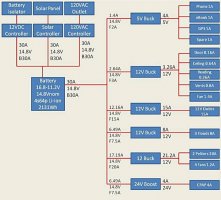
I'll have 4 USB charging ports, several 12V things, mostly lights and fans, and 1 24V outlet for my CPAP machine. After "translating" all those Amps back to 14.8V, I have an idea of how much current I'll be drawing from the battery if I ran everything at the same time. Comes out to something like 42A. Of course, I won't be running everything at the same time. That would be dumb. I played around with numbers for a while, and decided 30A is a good compromise between too much power, and not enough. Also, 30 is a nice round number, and I can get a breaker for that.
Note that in the above picture, I've got over 2000 Wh on the battery. Should be closer to 1400. I guess I fixed that after the screen capture.
Anyway, I know I won't be using everything at once, and I also know that I won't be using them all the time. I had to figure out both Amps and Watt-hours to know just how big to make the battery.

I may have made this image too small. I have that problem when sharing spreadsheet stuff.
What I did was to estimate at what capacity I would use each device. For example, the interior lights and reading lamp would probably need to be dimmed to be comfortable for me. The interior fan has two settings, Lo, and Hi, and I'll probably use it on low. The peltier A/C I'll use at less than full capacity. Say 50% on average. Things like that. Also, just because the 12V outlet can deliver 15A, it's unlikely I'll use it at 15A unless I have to inflate a tire. My electric tire pump has an initial surge of 15A then drops off to about 5-10A. Other things like the door light and the vent fans would always be run at full power.
Also, I had to estimate how many hours per day I would be using these devices. For example the floodlights are so I can see what's going on outside my trailer at night without getting out of it. Like if a bear is trying to steal my gas can for his dirt bike. Most days I wouldn't even turn them on. And since this is basically a sleeping box, I might run the interior lights for a couple hours and the reading lamp for maybe an hour.
After counting up all those things, I figured the battery will do an average of 10A for about 10 hours per day. But with the possibility of drawing as much as 30A at a single instant. And I'll need around 1400 Wh for the battery to last a whole day's use. Running this through all the regular math to build a battery, I came up with 4s64p, 256 cells total. Based on past experience I'll need around 45 laptop batteries' worth of cells.
What I haven't figured out yet is how to charge it. I'd like to be able to camp off grid, so I plan to have a solar panel and charge controller, which I think I've got figured out, but also, I might as well charge it off the motorcycle while I'm traveling, and I've got a battery isolator picked out. My motorcycle has a small car alternator on it rather than thestator and magneto things that regular bikes have, so it can generate quite a bit of power for a bike. But I need a 12VDC charge controller to safely charge the battery. I haven't found one yet. Also, when there is an electrical hookup, I'd like to charge the battery with 120VAC. I'll either need a controller for that, or a 120VAC to 12VDC converter capable of outputting, say, 10-30A. Haven't found anything like that either. I can balance easy enough with my iMax.
So if anyone knows of a good source for a charge controller, at least 10A output,for 4s batteries (one that just starts when you plug it in), I'd love to hear about it.





